- Manuals
- Brands
- Yamaha Manuals
- Offroad Vehicle
- RAPTOR 350
- Owner’s manual
-
Contents
-
Table of Contents
-
Troubleshooting
-
Bookmarks
Quick Links
READ THIS MANUAL CAREFULLY!
It contains important safety information.
OWNER’S MANUAL
YFM350RV
WARNING
This ATV should not be ridden by anyone under 16 years of age.
LIT-11626-19-68
5YT-28199-13
Related Manuals for Yamaha RAPTOR 350
Summary of Contents for Yamaha RAPTOR 350
-
Page 1
READ THIS MANUAL CAREFULLY! It contains important safety information. OWNER’S MANUAL YFM350RV WARNING This ATV should not be ridden by anyone under 16 years of age. LIT-11626-19-68 5YT-28199-13… -
Page 2
EBU00776… -
Page 3
Yamaha experience in the production of fine sporting, touring, and pacesetting racing machines. With the purchase of this Yamaha, you can now appreciate the high degree of crafts- manship and reliability that have made Yamaha a leader in these fields. -
Page 4: Warning
EBU00801 I MPORTANT MANUAL INFORMATION FAILURE TO FOLLOW THE WARNINGS CONTAINED IN THIS MANUAL CAN RESULT IN SERIOUS INJURY OR DEATH. Particularly important information is distinguished in this manual by the following notations: The Safety Alert Symbol means ATTENTION! BECOME ALERT! YOUR SAFETY IS INVOLVED! Failure to follow WARNING instructions could result in severe WARNING…
-
Page 5
Please check your local riding laws and regulations before operating this ATV. EBU13330 YFM350RV OWNER’S MANUAL ©2005 by Yamaha Motor Corporation, AFFIX DEALER U.S.A. 1st edition, June 2005 LABEL HERE All rights reserved. -
Page 6: Table Of Contents
EBU00014 CONTROL FUNCTIONS….4-1 WARNING Main switch ……..4-1 Indicates a potential hazard that could Indicator lights……..4-2 result in serious injury or death. Handlebar switches ……4-2 Throttle lever ……..4-4 Speed limiter ……..4-5 CONTENTS Clutch lever ……..4-6 Brake lever……..4-6 Brake pedal……..4-7 LOCATION OF THE WARNING Parking brake lever……4-8 AND SPECIFICATION LABELS..
-
Page 7
PRE-OPERATION CHECKS … 5-1 Parking……….6-9 Front and rear brakes ….. 5-2 Parking on a slope……6-10 Fuel ……….5-4 Accessories and loading ….6-11 Engine oil ……..5-6 Chain……….5-6 RIDING YOUR ATV ……7-1 Throttle lever ……..5-6 Getting to know your ATV …. -
Page 8
PERIODIC MAINTENANCE AND Adjusting the rear brake light ADJUSTMENT……..8-1 switch ………..8-27 Owner’s manual and tool kit…. 8-1 Clutch lever free play Periodic maintenance chart for adjustment ……..8-27 the emission control system..8-3 Drive chain slack check ….8-29 General maintenance and Drive chain slack adjustment..8-30 lubrication chart …… -
Page 9
Troubleshooting chart ….8-48 CLEANING AND STORAGE…. 9-1 A. Cleaning……..9-1 B. Storage ……..9-3 SPECIFICATIONS……10-1 NOISE REGULATION….11-1 MAINTENANCE RECORD …. 12-1 ATV LIMITED WARRANTY…. 13-1 YAMAHA EXTENDED SERVICE (Y.E.S.) ……….. 14-1… -
Page 10: Location Of The Warning And Specification Labels
EBU00464 LOCATION OF THE WARNING AND SPECIFICATION LABELS…
-
Page 11
ATV. Never remove any labels from your ATV. If a label becomes difficult to read or comes off, a replacement label is available from your Yamaha dealer. DRIVE SELECT LEVER Read owner’s manual carefully before operating. -
Page 12
WARNING UNDER Operating this ATV if you are under the age of 16 increases your chance of severe injury or death. NEVER operate this ATV if you are under age 16. 5FE-21697-01… -
Page 13: Safety Information
EBU13351 SAFETY INFORMATION AN ATV IS NOT A TOY AND CAN BE HAZARDOUS TO OPERATE. An ATV handles differently from other vehicles including motorcycles and cars. A collision or rollover can occur quickly, even during routine maneuvers such as turning and riding on hills or over obstacles, if you fail to take proper precautions.
-
Page 14
Always avoid operating an ATV on any paved surfaces, including sidewalks, driveways, park- ing lots and streets. Never operate an ATV on any public street, road or highway, even a dirt or gravel one. Never operate an ATV without wearing an approved motorcycle helmet that fits properly. You should also wear eye protection (goggles or face shield), gloves, boots, a long-sleeved shirt or jacket, and long pants. -
Page 15
Always follow proper procedures for turning as described in this manual. Practice turning at low speeds before attempting to turn at faster speeds. Do not turn at excessive speed. Never operate the ATV on hills too steep for the ATV or for your abilities. Practice on smaller hills before attempting larger hills. -
Page 16
Always use proper procedures if you stall or roll backwards when climbing a hill. To avoid stall- ing, use the proper gear and maintain a steady speed when climbing a hill. If you stall or roll backwards, follow the special procedure for braking described in this manual. Dismount on the uphill side or to a side if pointed straight uphill. -
Page 17
Always use the size and type of tires specified in this manual. Always maintain proper tire pressure as described in this manual. Never modify an ATV through improper installation or use of accessories. Never exceed the stated load capacity for an ATV. Cargo should be properly distributed and securely attached. -
Page 18
WARNING When transporting the ATV in another vehicle, be sure it is kept upright and POTENTIAL HAZARD that the fuel cock is in the “OFF” posi- Improper handling of gasoline. tion. Otherwise, fuel may leak out of the WHAT CAN HAPPEN carburetor or fuel tank. -
Page 19
WARNING POTENTIAL HAZARD Starting or running the engine in a closed area. WHAT CAN HAPPEN Exhaust fumes are poisonous and may cause loss of consciousness and death within a short time. HOW TO AVOID THE HAZARD Always operate your ATV in an area with adequate ventilation. -
Page 20: Description And Machine Identification
EBU00032 DESCRIPTION AND MACHINE IDENTIFICATION 1. Spark arrester 9. Fuel cock 2. Seat 10. Rear wheel 3. Drive select lever 11. Shift pedal 4. Fuel tank cap 12. Clutch lever 5. Main switch 13. Parking brake lever 6. Brake pedal 14.
-
Page 21: Identification Number Records
This number can be used for ordering a new when ordering spare parts from a Yamaha key. dealer or for reference in case the vehicle is stolen.
-
Page 22: Vehicle Identification Number
Record the information on this la- bel in the space provided. This information will be needed to order spare parts from your Yamaha dealer. 1. Vehicle identification number NOTE: The vehicle identification number is used to 1.
-
Page 23: Control Functions
EBU00039 CONTROL FUNCTIONS WARNING Indicates a potential hazard that could result in serious injury or death. EBU00942 Main switch Functions of the respective switch positions are as follows: The engine can be started only at this position and the headlights and taillight come on when the light switch is on.
-
Page 24: Indicator Lights
EBU00043 EBU00053 Indicator lights Handlebar switches 1. Reverse indicator light “R” 1. Light switch “ /OFF” 2. Neutral indicator light “N” 2. Engine stop switch “ ” 3. Start switch “ ” EBU14930 Reverse indicator light “R” EBU12040 Light switch “ /OFF”…
-
Page 25
EBU06070 Start switch “ ” CAUTION: The starter motor cranks the engine when this Do not use the headlights with the engine switch is pushed. turned off for more than thirty minutes. CAUTION: The battery may discharge to the point that the starter motor will not operate See starting instructions prior to starting properly. -
Page 26: Throttle Lever
Check the operation of the throttle lever before you start the engine. If it does not work smoothly, check for the cause. Correct the problem before riding the ATV. Consult a Yamaha dealer if you 1. Throttle lever can’t find or solve the problem yourself.
-
Page 27: Speed Limiter
EBU01159 Speed limiter WARNING The speed limiter keeps the throttle from fully POTENTIAL HAZARD opening, even when the throttle lever is Improper adjustment of the speed limit- pushed to the maximum. Turning in the ad- er and throttle. justing screw limits the maximum engine pow- WHAT CAN HAPPEN er available and decreases the maximum The throttle cable could be damaged.
-
Page 28: Clutch Lever
EBU00069 EBU00988 Clutch lever Brake lever The clutch lever is located on the left handle- The brake lever is located on the right handle- bar and the ignition circuit cut-off system is in- bar. Pull it toward the handlebar to apply the corporated in the clutch lever holder.
-
Page 29: Brake Pedal
EBU00989 Brake pedal The brake pedal is located on the right side of the machine. Push down on the pedal to apply the rear brake. 1. Brake pedal…
-
Page 30: Parking Brake Lever
EBU13870 Parking brake lever Use the parking brake when you have to start the engine or park the machine, especially on a slope. To apply the parking brake, move the parking brake lever in direction a. To release the parking brake, move the parking brake le- ver in direction b.
-
Page 31: Shift Pedal
EBU00082 Shift pedal WARNING This machine is equipped with a constant- POTENTIAL HAZARD mesh 6-speed transmission. The shift pedal is Improper use of the parking brake. located on the left side of the engine and is WHAT CAN HAPPEN used in combination with the clutch when The ATV could start moving unexpect- shifting.
-
Page 32: Drive Select Lever
EBU00085 EBU00092 Drive select lever Fuel tank cap The drive select lever is used for driving the Remove the fuel tank cap by turning it coun- machine either forward or in reverse. Refer to terclockwise. page 6-4 for drive select lever operation. 1.
-
Page 33: Fuel Cock
EBU00930 Fuel cock OFF Position The fuel cock supplies fuel from the fuel tank to the carburetor. The fuel cock has three positions. OFF: With the lever in this position, fuel will not flow. Always turn the lever to this position when the engine is not running.
-
Page 34: Starter (Choke)
EBU00950 Starter (choke) “ ” RES Position Starting a cold engine requires a richer air-fuel mixture. A separate starter circuit supplies this mixture. Move in direction a to turn on the starter (choke). Move in direction b to turn off the starter (choke).
-
Page 35: Seat
EBU00567 Seat To install the seat, insert the projections on To remove the seat, pull the seat lock lever the front of the seat into the seat holders and upward and pull up the seat at the rear. push down on the seat at the rear. NOTE: Make sure that the seat is securely fitted.
-
Page 36: Front Shock Absorber Adjustment
Front shock absorber adjustment A special wrench can be obtained at a The spring preload can be adjusted to suit the Yamaha dealer to make this adjustment. rider’s weight and riding conditions. Adjust the spring preload as follows. Standard position: C To increase the spring preload, turn the ad- justing ring in direction a.
-
Page 37
WARNING POTENTIAL HAZARD Improper shock absorber adjustment. WHAT CAN HAPPEN Uneven adjustment can cause poor handling and loss of stability, which could lead to an accident. HOW TO AVOID THE HAZARD Always adjust the shock absorbers on the left and right side to the same set- ting. -
Page 38: Rear Shock Absorber Adjustment
2. To increase the spring preload, turn the A special wrench can be obtained at a adjusting nut in direction a. To decrease Yamaha dealer to make this adjustment. the spring preload, turn the adjusting nut in direction b. 1. Special wrench 3.
-
Page 39
Measurement A: CAUTION: Installed length: Always tighten the locknut against the ad- Minimum (hard): 218.5 mm (8.6 in) justing nut and tighten it to the specified Standard: 228.5 mm (9.0 in) torque. Maximum (soft): 233.5 mm (9.2 in) A. Spring length 4. -
Page 40
Do not deform or damage the cylin- der in any way. EBU00112 Do not dispose of a damaged or WARNING worn out shock absorber yourself. Take the unit to a Yamaha dealer. Indicates a potential hazard that could result in serious injury or death. 4-18… -
Page 41: Pre-Operation Checks
PRE-OPERATION CHECKS Before using this machine, check the following points: ITEM ROUTINE PAGE • Check operation, fluid level and fluid leakage. 5-2–5-3, Brakes • Fill with DOT 4 brake fluid if necessary. 8-19–8-24 Clutch • Check operation, condition and lever free play. 8-27–8-28 Parking brake •…
-
Page 42: Front And Rear Brakes
POTENTIAL HAZARD Check that there is no free play in the brake Failure to inspect the ATV before oper- lever. If there is free play, have a Yamaha ating. dealer inspect the brake system. Failure to properly maintain the ATV.
-
Page 43
Riding with improperly operating the brakes firmly for one minute. If there is any brakes. leakage, have a Yamaha dealer inspect the WHAT CAN HAPPEN brake system. You could lose braking ability, which Brake operation could lead to an accident. -
Page 44: Fuel
EBU01085 Fuel Your Yamaha engine has been designed to Make sure there is sufficient gasoline in the use regular unleaded gasoline with a pump tank. octane number ([R+M]/2) of 86 or higher, or research octane number of 91 or higher. If…
-
Page 45
Fuel can spill, which can cause a fire hol containing methanol is not recommended and severe injury. by Yamaha because it may cause fuel system Fuel expands when it heats up. If the damage or vehicle performance problems. fuel tank is overfilled, fuel could spill out due to heat from the engine or the sun. -
Page 46: Engine Oil
Fittings and fasteners Always check the tightness of chassis fittings and fasteners before a ride. Take the machine Recommended engine oil type and to a Yamaha dealer or refer to the Service quantity: Manual for correct tightening torque. See page 10-2.
-
Page 47: Lights
Lights Check the headlights and tail/brake light to make sure they are in working condition. Re- pair as necessary for proper operation. EBU01170 Switches Check the operation of all switches. Have a Yamaha dealer repair as necessary for proper operation.
-
Page 48: Tires
The following are minimums: 1. The tires listed below have been ap- Front 22 kPa (0.22 kgf/cm , 3.2 psi) proved by Yamaha Motor Co., Ltd. Rear 22 kPa (0.22 kgf/cm , 3.2 psi) for this model. Other tire combina- tions are not recommended.
-
Page 49: How To Measure Tire Pressure
Set pressure with tires cold. 4. Use no more than the following Set tire pressures to the following specifica- pressures when seating the tire tions: beads. Front 250 kPa (2.5 kgf/cm , 36 psi) Recommended Minimum Maximum pressure Rear 250 kPa (2.5 kgf/cm , 36 psi) Higher pressures may cause the 25 kPa…
-
Page 50: Tire Wear Limit
EBU00160 Tire wear limit When the tire groove decreases to 3 mm (0.12 in) due to wear, replace the tire. a. Tire wear limit 5-10…
-
Page 51: Operation
2. Turn the fuel cock to “ON”. there is a control or function you do not 3. Turn the main switch to “ON” and the en- understand, ask your Yamaha dealer. gine stop switch to “ ”. 4. Shift the transmission into neutral.
-
Page 52
When the transmission is in neutral. The neutral indicator light should come on. If the light does not come on, ask a Yamaha dealer to inspect it. When the clutch is disengaged with the transmission and the drive select lever in any position. -
Page 53: Starting A Warm Engine
EBU00180 Starting a warm engine NOTE: If the engine fails to start, release the start To start a warm engine, refer to the “Starting a switch, then push it again. Pause a few sec- cold engine” section. The starter (choke) onds before the next attempt.
-
Page 54: Drive Select Lever Operation And Reverse Driving
If the light does not come on, CAUTION: ask a Yamaha dealer to inspect the machine. Before shifting, stop the machine and re- 5. Check behind you for people or obsta- turn the throttle lever to its closed posi- cles, and then release the brake pedal.
-
Page 55: Shifting
EBU01173 Shifting WARNING This model has a 6-speed forward and POTENTIAL HAZARD 1-speed reverse transmission. The transmis- Improperly operating in reverse. sion allows you to control the amount of pow- WHAT CAN HAPPEN er you have available at a given speed or for You could hit an obstacle or person be- starting, accelerating, climbing hills, etc.
-
Page 56: To Start Out And Accelerate
EBU14190 To start out and accelerate: CAUTION: 1. Release the throttle lever, and then re- Do not coast for long periods with the lease the parking brake. engine off, and do not tow the ma- chine a long distance. Even in neutral CAUTION: position, the transmission is only Always close the throttle while shifting…
-
Page 57: To Decelerate
EBU00207 8. Follow the same procedure when shifting To decelerate: to the next higher gear. When slowing down or stopping, release the throttle and apply the brakes smoothly and WARNING evenly. As you slow down, shift to a lower POTENTIAL HAZARD gear.
-
Page 58: Engine Break-In
Because the engine is If any abnormality is noticed during this peri- brand new, you must not put an excessive od, consult a Yamaha dealer. load on it for the first several hours of running. 0–10 hours:…
-
Page 59: Parking
EBU02111 Parking When parking, stop the engine and shift into first gear. Turn the fuel cock to “OFF” and ap- ply the parking brake. 1. Locked position…
-
Page 60: Parking On A Slope
EBU14730 Parking on a slope 3. Stop the engine by setting the engine stop switch to “ ”. WARNING 4. With the front and rear brakes applied, POTENTIAL HAZARD pull the clutch lever, shift into 1st gear, Parking on a hill or other incline. and then slowly release the clutch lever, WHAT CAN HAPPEN brake lever and brake pedal.
-
Page 61: Accessories And Loading
Choose only accessories designed for your Use extra caution when riding an ATV with ATV. Your Yamaha dealer has a variety of accessories. The ATV may handle differ- genuine Yamaha accessories. Other ac- ently than it does without accessories.
-
Page 62
EBU00584 Loading Tie down cargo securely to the carriers. As originally equipped, this ATV is not de- Make sure cargo in the trailer cannot move signed to carry cargo or tow a trailer. If you around. A shifting load can cause an acci- choose to add accessories so that you can dent. -
Page 63
WARNING POTENTIAL HAZARD Overloading this ATV or carrying or tow- ing cargo improperly. WHAT CAN HAPPEN Could cause changes in vehicle han- dling which could lead to an accident. HOW TO AVOID THE HAZARD Never exceed the stated load capacity for this ATV. -
Page 64
EBU13552 WARNING Indicates a potential hazard that could result in serious injury or death. 6-14… -
Page 65: Riding Your Atv
R iding Your…
-
Page 66: Getting To Know Your Atv
WARNING Indicates a potential hazard that could result in serious injury or death. GETTING TO KNOW YOUR ATV operation of the controls. Pay particular atten- This ATV is intended for recreational use by tion to the safety information on pages 2-1– experienced operators only.
-
Page 67: Ride With Care And Good Judgement
JUDGEMENT Beginning and inexperienced operators should complete the certified training Get training if you are inexperienced. course offered by Yamaha. They should Beginners should get training from a certified then regularly practice the skills learned instructor. in the course and the operating tech- Become familiar with this ATV at slow speeds niques described in this Owner’s Manu-…
-
Page 68
Not recommended for children under 16 years of age. WARNING POTENTIAL HAZARD Failure to follow the age recommenda- tions for this ATV. WHAT CAN HAPPEN Use by children of ATVs that are not rec- ommended for their age can lead to se- vere injury or death of the child. -
Page 69
This ATV is designed to carry operator only – passengers prohibited. WARNING POTENTIAL HAZARD Carrying a passenger on this ATV. WHAT CAN HAPPEN Greatly reduces your ability to balance and control this ATV. Could cause an accident, resulting in harm to you and/ or your passenger. -
Page 70
Apparel Operating without protective clothing WARNING increases your chances of severe injury in the event of an accident. POTENTIAL HAZARD HOW TO AVOID THE HAZARD Operating this ATV without wearing an Always wear an approved motorcycle approved motorcycle helmet, eye pro- helmet that fits properly. -
Page 71
Do not operate after consuming alcohol or WARNING drugs. POTENTIPOTENTIAL HAZARD Operator’s performance capability is reduced Operating this ATV after consuming al- by the influence of alcohol or drugs. cohol or drugs. WHAT CAN HAPPEN Could seriously affect your judgment. Could cause you to react more slowly. -
Page 72
Pre-operation checks WARNING Always perform the pre-operation checks list- POTENTIAL HAZARD ed on page 5-1 before riding for safety and Operating this ATV with improper tires, proper care of the ATV. or with improper or uneven tire pres- WARNING sure. POTENTIAL HAZARD WHAT CAN HAPPEN Failure to inspect the ATV before oper-… -
Page 73
Speed limiter WARNING For riders inexperienced with this model, this Indicates a potential hazard that could model is equipped with a speed limiter in the result in serious injury or death. throttle lever housing. The speed limiter limits the power and top speed of the ATV. Turning Do not operate at speeds too fast for your the adjusting screw in decreases the top skills or the conditions. -
Page 74
Loading and accessories WARNING As originally equipped, this ATV is not de- POTENTIAL HAZARD signed to carry cargo or tow a trailer. If you Overloading this ATV or carrying or tow- choose to add accessories so that you can ing cargo improperly. carry cargo or tow a trailer, you must use WHAT CAN HAPPEN common sense and good judgment. -
Page 75
During operation WARNING Always keep your feet on the footboards dur- POTENTIAL HAZARD ing operation. Otherwise your feet may con- Removing hands from handlebars or tact the rear wheels. feet from footboards during operation. WHAT CAN HAPPEN Removing even one hand or foot can re- duce your ability to control the ATV or could cause you to lose your balance and fall off of the ATV. -
Page 76
Avoid wheelies and jumping. You may lose control of the ATV or overturn. WARNING POTENTIAL HAZARD Attempting wheelies, jumps, and other stunts. WHAT CAN HAPPEN Increases the chance of an accident, in- cluding an overturn. HOW TO AVOID THE HAZARD Never attempt stunts, such as wheelies or jumps. -
Page 77
Never modify this ATV through improp- er installation or use of accessories. All parts and accessories added to this ve- hicle should be genuine Yamaha or equivalent components designed for use on this ATV and should be installed and used according to instructions. If you have questions, consult an autho- rized ATV dealer. -
Page 78
Exhaust system The exhaust system on the ATV is very hot during and following operation. To prevent burns, avoid touching the exhaust system. Park the ATV in a place where pedestrians or children are not likely to touch it. WARNING POTENTIAL HAZARD Hot exhaust system. -
Page 79: Be Careful Where You Ride
BE CAREFUL WHERE YOU RIDE This ATV is designed for off-road use only. Riding on paved surfaces can cause loss of control. WARNING POTENTIAL HAZARD Operating this ATV on paved surfaces. WHAT CAN HAPPEN ATVs are designed for off-road use only. Paved surfaces may seriously affect handling and control of the ATV, and may cause the vehicle to go out of con-…
-
Page 80
Do not ride on any public road, street, or high- way. Riding on public roads can result in collisions with other vehicles. WARNING POTENTIAL HAZARD Operating this ATV on public streets, roads or highways. WHAT CAN HAPPEN You can collide with another vehicle. HOW TO AVOID THE HAZARD Never operate this ATV on any public street, road or highway, even a dirt or… -
Page 81
Know the terrain where you ride. Ride cau- tiously in unfamiliar areas. Stay alert for holes, rocks, or roots in the terrain, and oth- er hidden hazards which may cause the ATV to upset. WARNING POTENTIAL HAZARD Failure to use extra care when operating this ATV on unfamiliar terrain. -
Page 82
WARNING POTENTIAL HAZARD Failure to use extra care when operating on excessively rough, slippery or loose terrain. WHAT CAN HAPPEN Could cause loss of traction or vehicle control, which could result in an acci- dent, including an overturn. HOW TO AVOID THE HAZARD Do not operate on excessively rough, slippery or loose terrain until you have learned and practiced the skills neces-… -
Page 83
When riding in an area where you might not WHAT CAN HAPPEN easily be seen, such as desert terrain, mount You could be in a collision. You could a caution flag on the ATV. DO NOT use the be injured. flag pole bracket as a trailer hitch. -
Page 84
Select a large, flat area off-road to become fa- With the engine idling, pull the clutch lever to miliar with your ATV. Make sure that this area disengage the clutch and shift into 1st gear, is free of obstacles and other riders. You and then release the parking brake. -
Page 85
When slowing down or stopping, release the WARNING throttle and apply the brakes smoothly and POTENTIAL HAZARD evenly. As you slow down, shift to a lower Opening the throttle abruptly or releas- gear. Be sure that the engine has sufficiently ing the clutch lever too quickly. -
Page 86: Turning Your Atv
TURNING YOUR ATV HOW TO AVOID THE HAZARD To achieve maximum traction while riding off- Always follow proper procedures for road, the two rear wheels are mounted solidly turning as described in this Owner’s on one axle and turn together at the same Manual.
-
Page 87
Once you have learned this technique you should be able to perform it at higher speeds or in tighter curves. Improper riding procedures such as abrupt throttle changes, excessive braking, incorrect body movements, or too much speed for the sharpness of the turn may cause the ATV to tip. -
Page 88: Climbing Uphill
CLIMBING UPHILL HOW TO AVOID THE HAZARD Use proper riding techniques to avoid vehicle Never operate the ATV on hills too steep overturns on hills. Be sure that you can ma- for the ATV or for your abilities. neuver your ATV well on flat ground before at- Practice on smaller hills before attempt- tempting any incline and then practice riding ing large hills.
-
Page 89
WARNING An obstacle, a sharp drop, or another vehicle or person could be on the other POTENTIAL HAZARD side of the hill. Climbing hills improperly. WHAT CAN HAPPEN Could cause loss of control or cause the ATV to overturn. HOW TO AVOID THE HAZARD Always follow proper procedures for climbing hills as described in this Own- er’s Manual. -
Page 90
If you are climbing a hill and you find that you When crossing the side of a hill: have not properly judged your ability to make Always follow proper procedures as de- it to the top, you should turn the ATV around scribed in the Owner’s Manual. -
Page 91
If your ATV has stalled or stopped and you WARNING believe you can continue up the hill, restart POTENTIAL HAZARD carefully to make sure you do not lift the front Stalling, rolling backwards or improper- wheels which could cause you to lose control. ly dismounting while climbing a hill. -
Page 92
Dismount on uphill side or to a side if pointed straight uphill. Turn the ATV around and remount, following the pro- cedure described in the Owner’s Manu- 7-29… -
Page 93: Riding Downhill
RIDING DOWNHILL WARNING When riding your ATV downhill, shift your POTENTIAL HAZARD weight as far to the rear and uphill side of the Going down a hill improperly. ATV as possible. Move back on the seat and WHAT CAN HAPPEN sit with your arms straight.
-
Page 94
7-31… -
Page 95: Crossing A Slope
CROSSING A SLOPE WARNING Traversing a sloping surface on your ATV re- POTENTIAL HAZARD quires you to properly position your weight to Improperly crossing hills or turning on maintain proper balance. Be sure that you hills. have learned the basic riding skills on flat WHAT CAN HAPPEN ground before attempting to cross a sloping Could cause loss of control or cause the…
-
Page 96
Avoid hills with excessively slippery or loose surfaces. Shift your weight to the uphill side of the ATV. 7-33… -
Page 97: Crossing Through Shallow Water
CROSSING THROUGH SHALLOW WATER Remember that wet brakes may have re- The ATV can be used to cross slow moving, duced stopping ability. Test your brakes shallow water of up to a maximum of 35 cm after leaving water. If necessary, apply (14 inches) in depth.
-
Page 98
Test your brakes after leaving the water. Do CAUTION: not continue to ride your ATV without verifying After riding your ATV in water, be sure to that you have regained proper braking ability. drain the trapped water by removing the check hose at the bottom of the air filter case. -
Page 99: Riding Over Rough Terrain
RIDING OVER ROUGH TERRAIN WARNING Riding over rough terrain should be done with POTENTIAL HAZARD caution. Look out for obstacles which could Improperly operating over obstacles. cause damage to the ATV or could lead to an WHAT CAN HAPPEN upset or accident. Be sure to keep your feet Could cause loss of control or a colli- firmly mounted on the footboards at all times.
-
Page 100
7-37… -
Page 101: Sliding And Skidding
SLIDING AND SKIDDING If the rear wheels of your ATV start to slide Care should be used when riding on loose or sideways, control can usually be regained (if slippery surfaces since the ATV may slide. If there is room to do so) by steering in the direc- unexpected and uncorrected, sliding could tion of the slide.
-
Page 102
With practice, over a period of time, skill at WARNING controlled sliding can be developed. The ter- POTENTIAL HAZARD rain should be chosen carefully before at- Skidding or sliding improperly. tempting such maneuvers, since both stability WHAT CAN HAPPEN and control are reduced. Bear in mind that You may lose control of this ATV. -
Page 103: What To Do If
WHAT TO DO IF … If your ATV starts to slide sideways: This section is designed to be a reference Steer in the direction of the slide if you have guide only. Be sure to read each section on the room. riding techniques completely.
-
Page 104
If your ATV is traversing a sloping surface: Be sure to ride with your weight positioned towards the uphill side of the ATV to main- tain proper balance. If the ATV starts to tip, steer down the hill (if there are no obstacles in your way) to regain balance. -
Page 105: Periodic Maintenance And Adjustment
EBU00515 PERIODIC MAINTENANCE AND Have a Yamaha dealer perform service if ADJUSTMENT you are not familiar with machine ser- vice. Periodic inspection, adjustment and lubrica- tion will keep your machine in the safest and most efficient condition possible. Safety is an EBU01221 obligation of the machine owner.
-
Page 106
HOW TO AVOID THE HAZARD during a service operation requiring one, take Never modify this ATV through improp- your machine to a Yamaha dealer to check er installation or use of accessories. All the torque settings and adjust them as neces- parts and accessories added to this ve- sary. -
Page 107: Periodic Maintenance Chart For The Emission Control System
However, keep in mind that if the ATV isn’t used for a long period of time, the month mainte- nance intervals should be followed. Items marked with an asterisk should be performed by a Yamaha dealer as they require special tools, data and technical skills.
-
Page 108: General Maintenance And Lubrication Chart
EBU15720 General maintenance and lubrication chart INITIAL EVERY month Whichever ITEM ROUTINE comes first 1,300 2,500 2,500 5,000 (mi) (200) (800) (1,600) (1,600) (3,200) hours • Clean. Every 20–40 hours Air filter element • Replace if necessary. (More often in wet or dusty areas.) Engine oil •…
-
Page 109
INITIAL EVERY month Whichever ITEM ROUTINE comes first 1,300 2,500 2,500 5,000 (mi) (200) (800) (1,600) (1,600) (3,200) hours • Check all chassis fittings and fasteners. Fittings and fasteners* • Correct if necessary. • Check operation. Lights and switches* • Adjust headlight beams. NOTE: Recommended brake fluid: DOT4 Brake fluid replacement:… -
Page 110: Engine Oil And Oil Filter Element
EBU11812 Engine oil and oil filter element 5. If the engine oil is at or below the mini- The engine oil level should be checked before mum level mark, add sufficient oil of the each ride. In addition, the oil must be changed recommended type to raise it to the cor- and the oil filter element cleaned at the inter- rect level.
-
Page 111
6. Insert the dipstick into the oil filler hole, and then tighten the engine oil filler cap. To change the engine oil (with or without oil filter element cleaning) 1. Place the ATV on a level surface. 2. Warm up the engine for several minutes, and then turn it off. -
Page 112
5. Remove the oil filter cover by removing 9. Install the oil filter cover by installing the the bolts, and then remove the oil filter el- bolts, and then tighten them to the speci- ement. fied torque. 6. Clean the oil strainer and oil filter element Tightening torque: with solvent. -
Page 113
11. Add the specified amount of the recom- CAUTION: mended engine oil, and then install and In order to prevent clutch slippage tighten the engine oil filler cap. (since the engine oil also lubricates the clutch), do not mix any chemical Recommended oil: additives. -
Page 114: Spark Plug Inspection
EBU14550 Spark plug inspection Removal 1. Remove the spark plug cap. 1. Spark plug wrench Inspection The spark plug is an important engine compo- nent and is easy to inspect. The condition of 1. Spark plug cap the spark plug can indicate the condition of 2.
-
Page 115
Instead, take the ATV to a Yamaha dealer. You should periodically remove and inspect the spark plug because heat and deposits will cause the spark plug to slowly break down and erode. If electrode erosion becomes ex- cessive, or if carbon and other deposits are excessive, you should replace the spark plug with the specified plug. -
Page 116: Air Filter Element Cleaning
EBU14920 Air filter element cleaning NOTE: If a torque wrench is not available when you NOTE: are installing a spark plug, a good estimate of There is a check hose at the bottom of the air the correct torque is 1/4 to 1/2 turn past finger filter case.
-
Page 117
1. Air filter case cover 2. Holder (× 4) 1. Air filter element assembly 3. Remove the air filter element assembly, and then remove the air filter element from its frame. 8-13… -
Page 118
WARNING POTENTIAL HAZARD Using low flash point solvents or gaso- line to clean the air filter element. WHAT CAN HAPPEN Low flash point solvents or gasoline can catch fire or explode. HOW TO AVOID THE HAZARD Use parts cleaning solvent to clean the 1. -
Page 119
7. Apply Yamaha foam air filter oil or other NOTE: The air filter element should be cleaned every quality foam air filter oil to the air filter el- 20–40 hours. It should be cleaned and lubri- ement. cated more often if the machine is operated in NOTE: extremely dusty areas. -
Page 120: Spark Arrester Cleaning
EBU13571 Spark arrester cleaning Be sure the exhaust pipe and muffler are cool before cleaning the spark arrester. 1. Remove the bolt. 1. Tailpipe 2. Spark arrester 4. Insert the tailpipe into the muffler and align the bolt holes. 5. Install and tighten the bolt. 1.
-
Page 121: Carburetor Adjustment
The carburetor is a vital part of the engine and POTENTIAL HAZARD requires very sophisticated adjustment. Most Improper cleaning of the spark arrester. adjusting should be left to a Yamaha dealer Hot exhaust system who has the professional knowledge and ex- WHAT CAN HAPPEN perience to do so.
-
Page 122: Idle Speed Adjustment
To prevent this, the valve clear- tion b to decrease the engine speed. ance must be adjusted regularly. This adjust- ment however, should be left to a professional Specified idle speed: Yamaha service technician. 1,450–1,550 r/min 8-18…
-
Page 123: Throttle Lever Adjustment
2. Turn the adjusting bolt until the throttle le- groove is almost in contact with the disc plate, ver free play is 2–4 mm (0.08–0.16 in). ask a Yamaha dealer to replace the brake 3. Tighten the locknut. pads as a set.
-
Page 124: Rear Brake Pad Inspection
If a brake pad is worn to the point that the wear indicator groove is almost in contact with the disc plate, ask a Yamaha dealer to replace the brake pads as a set. Rear 1.
-
Page 125: Brake Fluid Level Check
EBU13040 Brake fluid level check Rear Insufficient brake fluid may let air enter the brake system, possibly causing the brakes to become ineffective. Before riding, check that the brake fluid is above the minimum level mark and replenish if necessary. A low brake fluid level may indi- cate worn brake pads and/or brake system leakage.
-
Page 126: Brake Fluid Replacement
Replace the brake hoses every four years. Brake fluid may deteriorate painted surfac- es or plastic parts. Always clean up spilled fluid immediately. Have a Yamaha dealer check the cause if the brake fluid level goes down. 8-22…
-
Page 127: Front Brake Lever Free Play
The front brake lever should have a free play POTENTIAL HAZARD of zero mm (zero in) at the lever end. If not, Operating with improperly serviced or have a Yamaha dealer check the brake sys- adjusted brakes. tem. WHAT CAN HAPPEN You could lose braking ability, which could lead to an accident.
-
Page 128: Brake Pedal Height Adjustment
50.2 mm (1.98 in) above the top of the Operating with improperly serviced or frame as shown. If the brake pedal is not posi- adjusted brakes. tioned as specified, have a Yamaha dealer WHAT CAN HAPPEN adjust it. You could lose braking ability, which could lead to an accident.
-
Page 129: Parking Brake Adjustment
EBU14711 Parking brake adjustment 1. Release the parking brake by moving the Parking brake adjustment may be required if parking brake lever to the right. the parking brake does not hold properly. The 2. Fully loosen the locknut and the adjusting cable length A should be adjusted to 64–…
-
Page 130
NOTE: WARNING If the cable cannot be adjusted to specifica- tion, consult a Yamaha dealer. POTENTIAL HAZARD Operating with improperly adjusted 5. Tighten the locknut on the brake cable. brakes. 6. Screw in the adjusting bolt at the rear WHAT CAN HAPPEN… -
Page 131: Adjusting The Rear Brake Light Switch
EBU00833 EBU00741 Adjusting the rear brake light switch Clutch lever free play adjustment The rear brake light switch, which is activated The clutch lever free play should be adjusted by the brake pedal and brake lever, is proper- to 5–10 mm (0.20–0.39 in). ly adjusted when the brake light comes on just 1.
-
Page 132
4. Loosen the locknut at the clutch lever. 6. Loosen the locknut at the crankcase 5. Turn the adjusting bolt at the clutch lever side. in direction a to loosen the cable. 7. Turn the adjusting nut at the crankcase in direction a to increase the free play or in direction b to decrease the free play. -
Page 133: Drive Chain Slack Check
EBU01144 Drive chain slack check NOTE: Move the ATV back and forth and find the tightest position of the drive chain. Check and/ or adjust the chain slack while it is in this tight- est position. To check the drive chain slack, all tires must be touching the ground and there should be no weight on it.
-
Page 134: Drive Chain Slack Adjustment
EBU14990 Drive chain slack adjustment NOTE: There are alignment marks on each side of 1. Loosen the rear wheel hub upper and the swingarm and on the hub. Use them to lower bolts. check for proper wheel axle alignment. 1. Upper wheel hub bolt 2.
-
Page 135: Lubricating The Drive Chain
EBU00805 Lubricating the drive chain Tightening torques: The drive chain must be cleaned and lubricat- Locknut: ed at the intervals specified in the periodic 16 Nm (1.6 m·kgf, 11 ft·lbf) maintenance and lubrication chart, otherwise Upper wheel hub bolt: it will quickly wear out, especially when riding 120 Nm (12.0 m·kgf, 85 ft·lbf) in dusty or wet areas.
-
Page 136
CAUTION: Do not use engine oil or any other lubri- cants for the drive chain, as they may contain substances that could damage the O-rings. 1. O-ring 8-32… -
Page 137: Cable Inspection And Lubrication
WARNING Yamaha dealer to replace them. POTENTIAL HAZARD Damaged control cables. Recommended lubricant: Yamaha chain and cable lube or WHAT CAN HAPPEN Corrosion can result when the outer SAE 10W30 motor oil covering of control cables becomes damaged. Cables can also become EBU00737 frayed or kinked.
-
Page 138
8-34… -
Page 139: Lubricating The Front Upper And Lower Arm Pivots
EBU15060 Lubricating the front upper and lower arm Left pivots Lubricate the upper and lower arm pivots with a grease gun. Recommended lubricant: Lithium-soap-based grease Right 1. Upper grease nipple (× 2) 2. Lower grease nipple (× 2) 1. Upper grease nipple (× 2) 2. Lower grease nipple (× 2) 8-35…
-
Page 140: Rear Arm Pivot Lubrication
EBU00987 Rear arm pivot lubrication Lubricate the rear arm pivots. Recommended lubricant: Lithium-soap-based grease 1. Grease nipple 1. Grease nipple 1. Grease nipple 8-36…
-
Page 141: Wheel Removal
EBU01112 Wheel removal Rear 1. Loosen the wheel nuts. 2. Elevate the ATV and place a suitable stand under the frame. 3. Remove the nuts from the wheel. 4. Remove the wheel. Front 1. Nut (× 4) 1. Nut (× 4) 8-37…
-
Page 142: Wheel Installation
EBU08710 Wheel installation When installing the wheel, reverse the remov- al procedure. Tighten the wheel nuts to the specified torques. Tightening torques: Wheel nut: Front: 45 Nm (4.5 m·kgf, 32 ft·lbf) Rear: 45 Nm (4.5 m·kgf, 32 ft·lbf) 8-38…
-
Page 143: Battery
Therefore it is not necessary to check the electrolyte or add distilled water in the bat- tery. If the battery seems to have discharged, consult a Yamaha dealer. CAUTION: Do not try to remove the sealing caps of the battery cells. You may damage the bat- tery.
-
Page 144: Battery Maintenance
EBU03850 Battery maintenance HOW TO AVOID THE HAZARD 1. When the machine is not used for a Avoid contact with skin, eyes or cloth- month or longer, remove the battery and ing. Always shield eyes when working store it in a cool, dark place. Completely near batteries.
-
Page 145: Fuse Replacement
Then turn on the switch- An improper fuse can cause damage to es. If the fuse immediately blows again, the electrical system which could lead consult a Yamaha dealer. to a fire. Specified fuse: 15.0 A HOW TO AVOID THE HAZARD Always use a fuse of the specified rat- ing.
-
Page 146: Replacing A Headlight Bulb
EBU14721 Replacing a headlight bulb If a headlight bulb burns out, replace it as fol- lows. 1. Remove the headlight bulb holder cover at the rear of the headlight by pulling it off. 1. Headlight bulb holder 1. Headlight bulb holder cover 2.
-
Page 147
3. Remove the defective bulb from the 4. Install a new headlight bulb into the head- headlight unit by pulling it out. light unit by aligning the projection on the bulb with the groove in the headlight unit. WARNING POTENTIAL HAZARD A headlight bulb is hot when it is on and immediately after it is turned off. -
Page 148
CAUTION: Do not touch the glass part of the head- light bulb to keep it free from oil, otherwise the transparency of the glass, the luminos- ity of the bulb, and the bulb life will be ad- versely affected. Thoroughly clean off any dirt and fingerprints on the headlight bulb using a cloth moistened with alcohol or thinner. -
Page 149: Headlight Beam Adjustment
EBU12170 Headlight beam adjustment Tail/brake light bulb replacement CAUTION: It is advisable to have a Yamaha dealer make this adjustment. To raise the beam, turn the adjusting bolt in di- rection a. To lower the beam, turn the adjusting bolt in direction b.
-
Page 150
1. Bulb 3. Install a new bulb by pushing it inward and turning it clockwise. 4. Install the lens by installing the screws. CAUTION: Do not overtighten the screws as the lens may break. 8-46… -
Page 151: Troubleshooting
EBU00412 Troubleshooting WARNING Although Yamaha machines receive a rigid in- POTENTIAL HAZARD spection before shipment from the factory, Checking the fuel system while smok- trouble may occur during operation. Any prob- ing or near an open flame. lem in the fuel, compression, or ignition sys-…
-
Page 152: Troubleshooting Chart
No fuel. 2. Compression There is compression. Compression normal. Use the electric starter to see if there is compression. Ask a Yamaha dealer to No compression. inspect. 3. Ignition Wipe clean with dry cloth. Ignition system is Spark is good.
-
Page 153: Cleaning And Storage
EBU00417 CLEANING AND STORAGE CAUTION: Excessive water pressure may cause wa- A. CLEANING ter seepage and deterioration of wheel Frequent, thorough cleaning of your machine bearings, brakes, transmission seals and will not only enhance its appearance but will electrical devices. Many expensive repair improve its general performance and extend bills have resulted from improper high the useful life of many components.
-
Page 154
7. Clean the seat with a vinyl upholstery WARNING cleaner to keep the cover pliable and POTENTIAL HAZARD glossy. Operation with wet brakes after wash- 8. Automotive type wax may be applied to ing. all painted and chrome plated surfaces. WHAT CAN HAPPEN Avoid combination cleaner-waxes. -
Page 155: Storage
Do not apply oil to NOTE: any rubber parts or the seat cover. Use of fuel stabilizer and conditioner elimi- nates the need to drain the fuel system. Con- sult a Yamaha dealer if the fuel system needs to be drained instead.
-
Page 156
8. Remove the battery and charge it. Store it in a dry place and recharge it once a month. Do not store the battery in an ex- cessively warm or cold place (less than 0 °C (30 °F) or more than 30 °C (90 °F)). NOTE: Make any necessary repairs before storing the machine. -
Page 157: Specifications
EBU00428 S PECIFICATIONS MODEL YFM350R Dimension: Overall length 1,770 mm ( 69.7 in) Overall width 1,095 mm ( 43.1 in) Overall height 1,080 mm ( 42.5 in) Seat height 820 mm ( 32.3 in) Wheel base 1,210 mm ( 47.6 in) Ground clearance 115 mm ( 4.53 in) Minimum turning radius…
-
Page 158
MODEL YFM350R Engine oil: 0˚ 90˚ 110˚ 130˚F 10˚ 30˚ 50˚ 70˚ Type YAMALUBE 4 (20W40) or SAE 20W40 YAMALUBE 4 (10W30) or SAE 10W30 SAE 5W30 -20˚ 30˚ 40˚ 50˚C -10˚ 0˚ 10˚ 20˚ Recommended engine oil classification: API Service SE, SF, SG type or higher CAUTION: In order to prevent clutch slippage (since the en- gine oil also lubricates the clutch), do not mix any… -
Page 159
MODEL YFM350R Air filter: Wet element Fuel: Type UNLEADED GASOLINE ONLY Tank capacity 9.0 L (1.98 Imp gal, 2.38 US gal) Reserve amount 2.7 L (0.59 Imp gal, 0.71 US gal) Carburetor: Type × quantity BSR36 × 1 Manufacturer MIKUNI Spark plug: Type/manufacturer DR8EA / NGK… -
Page 160
MODEL YFM350R Gear ratio: 36/16 × 20/27 × 29/18 (2.685) 33/20 × 20/27 × 29/18 (1.969) 29/23 × 20/27 × 29/18 (1.504) 27/26 × 20/27 × 29/18 (1.239) 25/28 × 20/27 × 29/18 (1.065) 23/29 × 20/27 × 29/18 (0.946) 33/16 ×… -
Page 161
MODEL YFM350R Wheel travel: Front 200.0 mm (7.87 in) Rear 210.0 mm (8.27 in) Electrical: Ignition system D.C. C.D.I. Generator system A.C. magneto Battery type/voltage capacity YTZ10S/12V, 8.6Ah Headlight type: Krypton bulb Bulb voltage, wattage × quantity: 12V, 30W/30.0W × 2 Headlight 12V, 5W/21.0W ×… -
Page 162: Noise Regulation
EBU00430 N OISE REGULATION TAMPERING WITH NOISE CONTROL SYSTEM PROHIBITED: Federal law prohibits the following acts or the causing thereof: (1) The removal or rendering inop- erative by any person other than for purposes of maintenance, repair, or replacement of any de- vice or element of design incorporated into any new vehicle for the purpose of noise control prior to its sale or delivery to the ultimate purchaser or while it is in use or (2) the use of the vehicle after such device or element of design has been removed or rendered inoperative by any person.
-
Page 163: Maintenance Record
EBU15740 M AINTENANCE RECORD Copies of work orders and/or receipts for parts you purchase and install will be required to docu- ment maintenance done in accordance with the warranty. The chart below is printed only as a re- minder to you that the maintenance work is required. It is not acceptable proof of maintenance work.
-
Page 164: Atv Limited Warranty
EBU00432 YAMAHA MOTOR CORPORATION, U.S.A. ATV LIMITED WARRANTY 13-1…
-
Page 165
13-2… -
Page 166: Yamaha Extended Service (Y.e.s.)
EBU00435 Y AMAHA EXTENDED SERVICE (Y.E.S.) 14-1…
-
Page 167
EBU00436 WARNING Indicates a potential hazard that could result in serious injury or death. 14-2… -
Page 168
EBU00437… -
Page 169
LOCATE AND READ OWNER’S MANUAL. FOLLOW ALL INSTRUCTIONS AND WARNINGS. (For replacement manual, call 1-800-532-1558) YAMAHA MOTOR CO., LTD. PRINTED ON RECYCLED PAPER PRINTED IN JAPAN 2005.07-3.2×1 CR…
This manual is also suitable for:
Yfm350rv
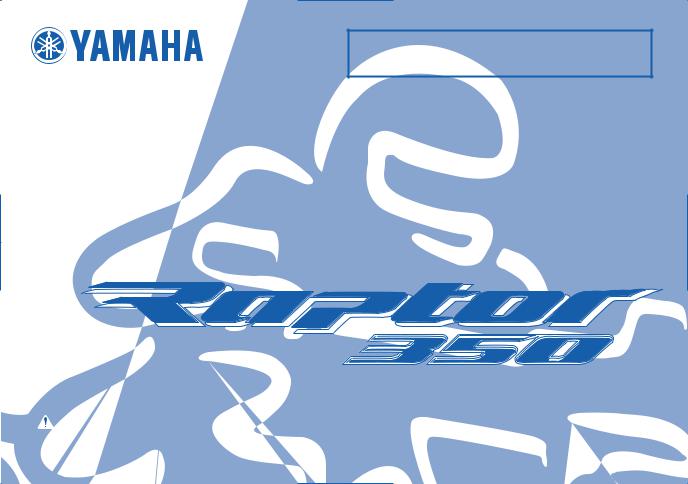
READ THIS MANUAL CAREFULLY!
It contains important safety information.
OWNER’S MANUAL
YFM350RV
|
WARNING |
This ATV should not be ridden by anyone under 16 years of age. |
|
LIT-11626-19-68 |
5YT-28199-13 |

EBU00776
EBU13320
INTRODUCTION
Congratulations on your purchase of the Yamaha YFM350R. It represents the result of many years of Yamaha experience in the production of fine sporting, touring, and pacesetting racing machines. With the purchase of this Yamaha, you can now appreciate the high degree of craftsmanship and reliability that have made Yamaha a leader in these fields.
This manual will provide you with a good basic understanding of the features and operation of this ATV. This manual includes important safety information. It provides information about special techniques and skills necessary to ride your ATV. It also includes basic maintenance and inspection procedures. If you have any questions regarding the operation or maintenance of your ATV, please consult a Yamaha dealer.
AN IMPORTANT SAFETY MESSAGE:
●READ THIS MANUAL TOGETHER WITH TIPS FOR THE ATV RIDER CAREFULLY AND COMPLETELY BEFORE OPERATING YOUR ATV. MAKE SURE YOU UNDERSTAND ALL INSTRUCTIONS.
●PAY CLOSE ATTENTION TO THE WARNING AND CAUTION LABELS ON THE ATV.
●NEVER OPERATE AN ATV WITHOUT PROPER TRAINING OR INSTRUCTION. FREE TRAINING IS AVAILABLE TO ANYONE WHO BUYS A NEW ATV. CALL 1-800-887-2887 FOR MORE INFORMATION.
●THIS ATV, AND ANY OTHER ATV OVER 90cc, SHOULD NOT BE RIDDEN BY ANYONE UNDER 16 YEARS OF AGE.
●THIS ATV IS A HIGH PERFORMANCE ATV FOR OFF-ROAD USE ONLY, FOR SPORT TYPE RECREATIONAL AND COMPETITIVE USE BY EXPERIENCED OPERATORS.
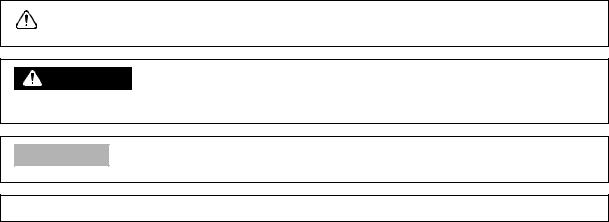
EBU00801
IMPORTANT MANUAL INFORMATION
FAILURE TO FOLLOW THE WARNINGS CONTAINED IN THIS MANUAL CAN RESULT IN SERIOUS INJURY OR DEATH.
Particularly important information is distinguished in this manual by the following notations:
The Safety Alert Symbol means ATTENTION! BECOME ALERT!
YOUR SAFETY IS INVOLVED!
|
WARNING |
Failure to follow WARNING instructions could result in severe |
|
|
injury or death to the machine operator, a bystander or a person |
||
|
inspecting or repairing the machine. |
||
|
CAUTION: |
A CAUTION indicates special precautions that must be taken to |
|
|
avoid damage to the machine. |
||
NOTE: A NOTE provides key information to make procedures easier or clearer.

EBU15000
IMPORTANT NOTICE
This ATV is designed and manufactured for OFF-ROAD use only. It is illegal and unsafe to operate this ATV on any public street, road or highway.
This ATV complies with all applicable OFF-ROAD noise level and spark arrester laws and regulations in effect at the time of manufacture.
Please check your local riding laws and regulations before operating this ATV.
EBU13330
YFM350RV
OWNER’S MANUAL
AFFIX DEALER
©2005 by Yamaha Motor Corporation, U.S.A.
LABEL HERE
1st edition, June 2005 All rights reserved.
Any reprinting or unauthorized use without the written permission
of Yamaha Motor Corporation, U.S.A. is expressly prohibited.
Printed in Japan.
P/N LIT-11626-19-68

EBU00014

Indicates a potential hazard that could result in serious injury or death.
CONTENTS |
|||
|
1 |
LOCATION OF THE WARNING |
||
|
AND SPECIFICATION LABELS |
1-1 |
||
|
2 |
SAFETY INFORMATION……………… |
2-1 |
|
|
3 |
DESCRIPTION AND MACHINE |
||
|
IDENTIFICATION |
3-1 |
||
|
Identification number records………. |
3-2 |
||
|
Key identification number……………. |
3-2 |
||
|
Vehicle identification number ………. |
3-3 |
||
|
Model label ……………………………….. |
3-3 |
|
4 |
CONTROL FUNCTIONS |
……………….4-1 |
|
|
Main switch |
4-1 |
||
|
Indicator lights……………………………. |
4-2 |
||
|
Handlebar switches ……………………. |
4-2 |
||
|
Throttle lever ……………………………… |
4-4 |
||
|
Speed limiter ……………………………… |
4-5 |
||
|
Clutch lever ……………………………….. |
4-6 |
||
|
Brake lever………………………………… |
4-6 |
||
|
Brake pedal……………………………….. |
4-7 |
||
|
Parking brake lever…………………….. |
4-8 |
||
|
Shift pedal …………………………………. |
4-9 |
||
|
Drive select lever ……………………… |
4-10 |
||
|
Fuel tank cap …………………………… |
4-10 |
||
|
Fuel cock…………………………………. |
4-11 |
||
|
Starter (choke) …………………………. |
4-12 |
||
|
Seat………………………………………… |
4-13 |
||
|
Front shock absorber |
|||
|
adjustment …………………………….. |
4-14 |
||
|
Rear shock absorber |
|||
|
adjustment …………………………….. |
4-16 |

|
5 |
PRE-OPERATION CHECKS ……….. |
5-1 |
|
|
Front and rear brakes |
5-2 |
||
|
Fuel …………………………………………. |
5-4 |
||
|
Engine oil …………………………………. |
5-6 |
||
|
Chain……………………………………….. |
5-6 |
||
|
Throttle lever …………………………….. |
5-6 |
||
|
Fittings and fasteners…………………. |
5-6 |
||
|
Lights……………………………………….. |
5-7 |
||
|
Switches…………………………………… |
5-7 |
||
|
Tires ………………………………………… |
5-8 |
||
|
How to measure tire pressure……… |
5-9 |
||
|
Tire wear limit………………………….. |
5-10 |
||
|
6 |
OPERATION………………………………. |
6-1 |
|
|
Starting a cold engine |
6-1 |
||
|
Starting a warm engine………………. |
6-3 |
||
|
Warming up………………………………. |
6-3 |
||
|
Drive select lever operation and |
|||
|
reverse driving…………………………. |
6-4 |
||
|
Shifting …………………………………….. |
6-5 |
||
|
To start out and accelerate …………. |
6-6 |
||
|
To decelerate ……………………………. |
6-7 |
||
|
Engine break-in…………………………. |
6-8 |
|
Parking……………………………………… |
6-9 |
|
Parking on a slope……………………. |
6-10 |
|
Accessories and loading …………… |
6-11 |
|
7 |
RIDING YOUR ATV …………………….. |
7-1 |
|
|
Getting to know your ATV |
7-3 |
||
|
Ride with care and good |
|||
|
judgement……………………………….. |
7-4 |
||
|
Be careful where you ride………….. |
7-16 |
||
|
Turning your ATV …………………….. |
7-23 |
||
|
Climbing uphill …………………………. |
7-25 |
||
|
Riding downhill ………………………… |
7-30 |
||
|
Crossing a slope………………………. |
7-32 |
||
|
Crossing through shallow |
|||
|
water…………………………………….. |
7-34 |
||
|
Riding over rough terrain…………… |
7-36 |
||
|
Sliding and skidding………………….. |
7-38 |
||
|
What to do if…………………………….. |
7-40 |
||
|
What to do ……………………………… |
7-40 |

|
8 |
PERIODIC MAINTENANCE AND |
||
|
ADJUSTMENT |
8-1 |
||
|
Owner’s manual and tool kit………… |
8-1 |
||
|
Periodic maintenance chart for |
|||
|
the emission control system………. |
8-3 |
||
|
General maintenance and |
|||
|
lubrication chart ……………………….. |
8-4 |
||
|
Engine oil and oil filter element ……. |
8-6 |
||
|
Spark plug inspection……………….. |
8-10 |
||
|
Air filter element cleaning………….. |
8-12 |
||
|
Spark arrester cleaning …………….. |
8-16 |
||
|
Carburetor adjustment………………. |
8-17 |
||
|
Idle speed adjustment ………………. |
8-18 |
||
|
Valve clearance adjustment………. |
8-18 |
||
|
Throttle lever adjustment…………… |
8-19 |
||
|
Front brake pad inspection………… |
8-19 |
||
|
Rear brake pad inspection ………… |
8-20 |
||
|
Brake fluid level check………………. |
8-21 |
||
|
Brake fluid replacement…………….. |
8-22 |
||
|
Front brake lever free play ………… |
8-23 |
||
|
Brake pedal height adjustment…… |
8-24 |
||
|
Parking brake adjustment …………. |
8-25 |
|
Adjusting the rear brake light |
|
|
switch ……………………………………. |
8-27 |
|
Clutch lever free play |
|
|
adjustment …………………………….. |
8-27 |
|
Drive chain slack check …………….. |
8-29 |
|
Drive chain slack adjustment……… |
8-30 |
|
Lubricating the drive chain…………. |
8-31 |
|
Cable inspection and lubrication…. |
8-33 |
|
Brake and shift pedal/brake and |
|
|
clutch lever lubrication …………….. |
8-33 |
|
Lubricating the front upper and |
|
|
lower arm pivots……………………… |
8-35 |
|
Rear arm pivot lubrication………….. |
8-36 |
|
Wheel removal…………………………. |
8-37 |
|
Wheel installation……………………… |
8-38 |
|
Battery…………………………………….. |
8-39 |
|
Battery maintenance…………………. |
8-40 |
|
Fuse replacement …………………….. |
8-41 |
|
Replacing a headlight bulb ………… |
8-42 |
|
Headlight beam adjustment……….. |
8-45 |
|
Tail/brake light bulb |
|
|
replacement …………………………… |
8-45 |
|
Troubleshooting ……………………….. |
8-47 |

|
Troubleshooting chart ………………. |
8-48 |
|
9 |
CLEANING AND STORAGE………… |
9-1 |
|
|
A. Cleaning |
9-1 |
||
|
B. Storage ………………………………… |
9-3 |
|
10 |
SPECIFICATIONS…………………….. 10-1 |
|
11 |
NOISE REGULATION……………….. 11-1 |
|
12 |
MAINTENANCE RECORD ………… 12-1 |
|
13 |
ATV LIMITED WARRANTY………… 13-1 |
|
14 |
YAMAHA EXTENDED SERVICE |
|
|
(Y.E.S.) ……………………………………. 14-1 |
||
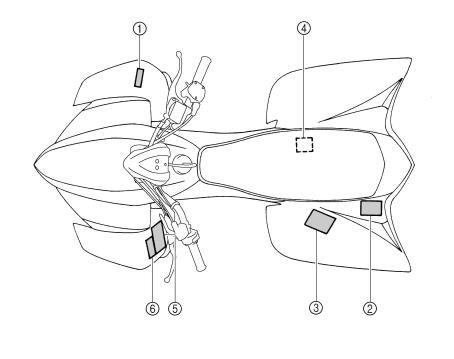
EBU00464
LOCATION OF THE WARNING AND
SPECIFICATION LABELS
1-1
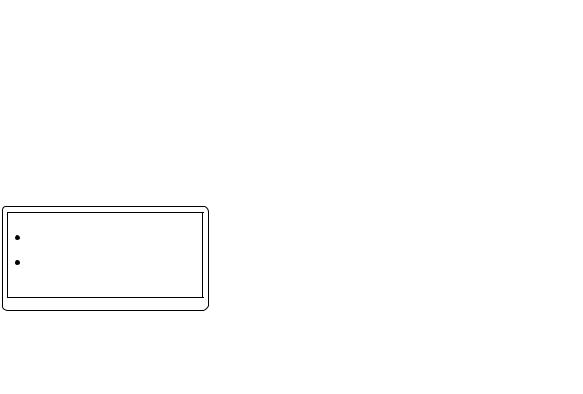
|
Read and understand all of the labels on your |
2 |
|
|
machine. They contain important information |
1 |
|
for safe and proper operation of your ATV.
Never remove any labels from your ATV. If a label becomes difficult to read or comes off, a replacement label is available from your Yamaha dealer.
|
1 |
3 |
||
|
DRIVE SELECT LEVER |
|||
|
Read owner’s manual carefully |
|||
|
before operating. |
|||
|
When shifting the drive select lever, |
|||
|
always be sure to stop the ATV |
|||
|
and apply the rear brake. |
|||
|
5YT-2151E-30 |
1-2

6
WARNING
UNDER
Operating this ATV if you are under the age of 16 increases your chance of severe injury or death.
NEVER operate this ATV if you are under age 16.
5FE-21697-01
1-3

EBU13351
 SAFETY INFORMATION
SAFETY INFORMATION
2
AN ATV IS NOT A TOY AND CAN BE HAZARDOUS TO OPERATE. An ATV handles differently from other vehicles including motorcycles and cars. A collision or rollover can occur quickly, even during routine maneuvers such as turning and riding on hills or over obstacles, if you fail to take proper precautions.
SEVERE INJURY OR DEATH can result if you do not follow these instructions:
●Read this manual and all labels carefully and follow the operating procedures described.
●Never operate an ATV without proper training or instruction. Take a Training Course. Beginners should receive training from a certified instructor. Contact an authorized ATV dealer or call 1-800-887-2887 to find out about the training courses nearest you.
●Always follow the age recommendation:
– A child under 16 years old should never operate an ATV with engine size greater than 90cc.
●Never allow a child under age 16 to operate an ATV without adult supervision, and never allow continued use of an ATV by a child if he or she does not have the abilities to operate it safely.
●Never carry a passenger on an ATV.
2-1
●Always avoid operating an ATV on any paved surfaces, including sidewalks, driveways, parking lots and streets.
●Never operate an ATV on any public street, road or highway, even a dirt or gravel one.
●Never operate an ATV without wearing an approved motorcycle helmet that fits properly. You should also wear eye protection (goggles or face shield), gloves, boots, a long-sleeved shirt or jacket, and long pants.
●Never consume alcohol or drugs before or while operating this ATV.
●Never operate at speeds too fast for your skills or the conditions. Always go at a speed that is proper for the terrain, visibility, operating conditions, and your experience.
●Never attempt wheelies, jumps, or other stunts.
●Always inspect your ATV each time you use it to make sure it is in safe operating condition. Always follow the inspection and maintenance procedures and schedules described in this manual.
●Always keep both hands on the handlebars and both feet on the footboards of the ATV during operation.
●Always go slowly and be extra careful when operating on unfamiliar terrain. Always be alert to changing terrain conditions when operating the ATV.
●Never operate on excessively rough, slippery or loose terrain until you have learned and practiced the skills necessary to control the ATV on such terrain. Always be especially cautious on these kinds of terrain.
2-2
●Always follow proper procedures for turning as described in this manual. Practice turning at low speeds before attempting to turn at faster speeds. Do not turn at excessive speed.
●Never operate the ATV on hills too steep for the ATV or for your abilities. Practice on smaller hills before attempting larger hills.
●Always follow proper procedures for climbing hills as described in this manual. Check the terrain carefully before you start up any hill. Never climb hills with excessively slippery or loose surfaces. Shift your weight forward. Never open the throttle suddenly or make sudden gear changes. Never go over the top of a hill at high speed.
●Always follow proper procedures for going down hills and for braking on hills as described in this manual. Check the terrain carefully before you start down any hill. Shift your weight backward. Never go down a hill at high speed. Avoid going down a hill at an angle that would cause the vehicle to lean sharply to one side. Go straight down the hill where possible.
●Always follow proper procedures for crossing the side of a hill as described in this manual. Avoid hills with excessively slippery or loose surfaces. Shift your weight to the uphill side of the ATV. Never attempt to turn the ATV around on any hill until you have mastered the turning technique described in this manual on level ground. Avoid crossing the side of a steep hill if possible.
2-3
●Always use proper procedures if you stall or roll backwards when climbing a hill. To avoid stalling, use the proper gear and maintain a steady speed when climbing a hill. If you stall or roll backwards, follow the special procedure for braking described in this manual. Dismount on the uphill side or to a side if pointed straight uphill. Turn the ATV around and remount, following the procedure described in this manual.
●Always check for obstacles before operating in a new area. Never attempt to operate over large obstacles, such as large rocks or fallen trees. Always follow proper procedures when operating over obstacles as described in this manual.
●Always be careful when skidding or sliding. Learn to safely control skidding or sliding by practicing at low speeds and on level, smooth terrain. On extremely slippery surfaces, such as ice, go slowly and be very cautious in order to reduce the chance of skidding or sliding out of control.
●Never operate an ATV in fast flowing water or in water deeper than that recommended in this manual. Remember that wet brakes may have reduced stopping ability. Test your brakes after leaving water. If necessary, apply them several times to let friction dry out the linings.
●Always be sure there are no obstacles or people behind you when you operate in reverse. When it is safe to proceed in reverse, go slowly.
2-4
●Always use the size and type of tires specified in this manual.
●Always maintain proper tire pressure as described in this manual.
●Never modify an ATV through improper installation or use of accessories.
●Never exceed the stated load capacity for an ATV. Cargo should be properly distributed and securely attached. Reduce speed and follow instructions in this manual for carrying cargo or pulling a trailer. Allow greater distance for braking.
FOR MORE INFORMATION ABOUT ATV SAFETY, call the Consumer Products Safety Commission at 1-800-638-2772, or the ATV Distributor’s Safety Hotline at 1-800-852-5344.
2-5
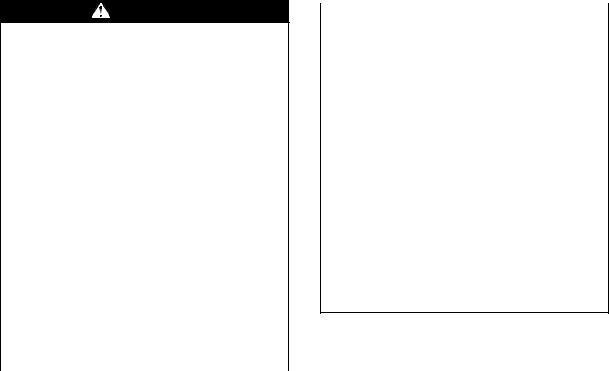
WARNING
POTENTIAL HAZARD Improper handling of gasoline. WHAT CAN HAPPEN
Gasoline can catch fire and you could be burned.
HOW TO AVOID THE HAZARD
Always turn off the engine when refueling.
Do not refuel immediately after the engine has been running and is still very hot.
Do not spill gasoline on the engine or exhaust pipe/muffler when refueling. Never refuel while smoking, or in the vicinity of sparks, open flames, or other sources of ignition such as the pilot lights of water heaters and clothes dryers.
When transporting the ATV in another vehicle, be sure it is kept upright and that the fuel cock is in the “OFF” position. Otherwise, fuel may leak out of the carburetor or fuel tank.
WHAT CAN HAPPEN
Gasoline is poisonous and can cause injuries.
HOW TO AVOID THE HAZARD
If you should swallow some gasoline or inhale a lot of gasoline vapor, or get some gasoline in your eyes, see your doctor immediately. If gasoline spills on your skin, wash with soap and water. If gasoline spills on your clothing, change your clothes.
2-6
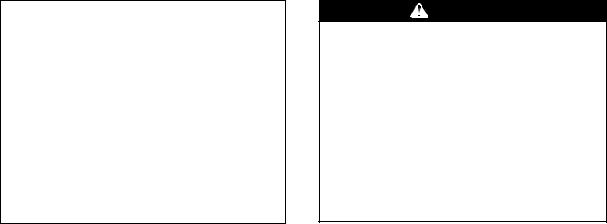
WARNING
POTENTIAL HAZARD
Starting or running the engine in a closed area.
WHAT CAN HAPPEN
Exhaust fumes are poisonous and may cause loss of consciousness and death within a short time.
HOW TO AVOID THE HAZARD
Always operate your ATV in an area with adequate ventilation.
2-7

EBU00032
DESCRIPTION AND MACHINE IDENTIFICATION
|
1. |
Spark arrester |
9. |
Fuel cock |
|
2. |
Seat |
10. |
Rear wheel |
|
3. |
Drive select lever |
11. |
Shift pedal |
|
4. |
Fuel tank cap |
12. |
Clutch lever |
|
5. |
Main switch |
13. |
Parking brake lever |
|
6. |
Brake pedal |
14. |
Brake lever |
|
7. |
Headlights |
15. |
Throttle lever |
|
8. |
Front wheel |
16. |
Handlebar switches |
NOTE:
The machine you have purchased may differ slightly from those shown in the figures of this manual.
3-1

EBU00600
Identification number records
Record the key identification number, vehicle identification number and model label information in the spaces provided for assistance when ordering spare parts from a Yamaha dealer or for reference in case the vehicle is stolen.
1.KEY IDENTIFICATION NUMBER:
2.VEHICLE IDENTIFICATION NUMBER:
3.MODEL LABEL INFORMATION:
|
EBU00035 |
|
Key identification number |
|
|
The key identification number is stamped on |
|
|
the key as shown in the following illustration. |
|
|
This number can be used for ordering a new |
3 |
|
key. |
1. Key identification number
3-2

|
EBU00036 |
EBU00787 |
|
Vehicle identification number |
Model label |
|
|
The vehicle identification number is stamped |
The model label is affixed to the location in the |
|
|
into the frame. |
illustration. Record the information on this la- |
|
|
bel in the space provided. This information will |
||
|
be needed to order spare parts from your |
||
|
Yamaha dealer. |
||
1. Vehicle identification number
NOTE:
The vehicle identification number is used to
identify your machine.
1. Model label
3-3

EBU00039
CONTROL FUNCTIONS

Indicates a potential hazard that could result in serious injury or death.
4
EBU00942
Main switch
Functions of the respective switch positions are as follows:
ON:
The engine can be started only at this position and the headlights and taillight come on when the light switch is on.
OFF:
All electrical circuits are switched off. The key can be removed in this position.
4-1

EBU00043
Indicator lights
1.Reverse indicator light “R”
2.Neutral indicator light “N”
EBU14930
Reverse indicator light “R”
This indicator light comes on when the drive select lever is in reverse.
EBU00603
Neutral indicator light “N”
This indicator light comes on when the transmission is in neutral.
EBU00053
Handlebar switches
1.Light switch “

2.Engine stop switch “

3.Start switch “
EBU12040
Light switch “

Set the switch to “
Set the switch to “ 
Set the switch to “OFF” to turn off all the lights.
4-2
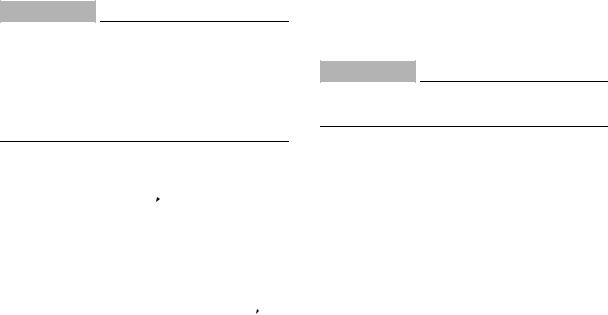
CAUTION:
Do not use the headlights with the engine turned off for more than thirty minutes. The battery may discharge to the point that the starter motor will not operate properly. If this should happen, remove the battery and recharge it.
EBU12050
Engine stop switch “

Make sure that the engine stop switch is set to “ 

EBU06070
Start switch “ 
The starter motor cranks the engine when this switch is pushed.
CAUTION:
See starting instructions prior to starting the engine. (See page 6-1 for details.)
4-3
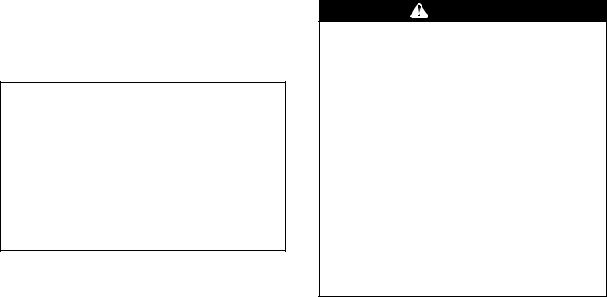
EBU00062
Throttle lever
Once the engine is running, movement of the throttle lever will increase the engine speed. Regulate the speed of the machine by varying the throttle position. Because the throttle is spring-loaded, the machine will decelerate, and the engine will return to an idle any time the hand is removed from the throttle lever.
1. Throttle lever
Before starting the engine, check the throttle to be sure it is operating smoothly. Make sure it returns to the idle position as soon as the lever is released.
WARNING
POTENTIAL HAZARD
Malfunction of throttle.
WHAT CAN HAPPEN
The throttle could be hard to operate, making it difficult to speed up or slow down when you need to. This could cause an accident.
HOW TO AVOID THE HAZARD
Check the operation of the throttle lever before you start the engine. If it does not work smoothly, check for the cause. Correct the problem before riding the ATV. Consult a Yamaha dealer if you can’t find or solve the problem yourself.
4-4
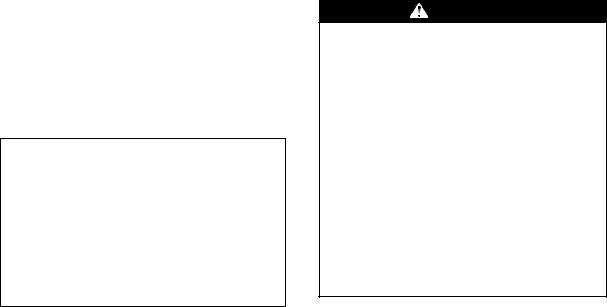
EBU01159
Speed limiter
The speed limiter keeps the throttle from fully opening, even when the throttle lever is pushed to the maximum. Turning in the adjusting screw limits the maximum engine power available and decreases the maximum speed of the ATV.
|
1. Locknut |
2. Adjusting screw |
a. No more than 12 mm (0.47 in)
WARNING
POTENTIAL HAZARD
Improper adjustment of the speed limiter and throttle.
WHAT CAN HAPPEN
The throttle cable could be damaged. Improper throttle operation could result. You could lose control, have an accident or be injured.
HOW TO AVOID THE HAZARD
Do not turn the adjusting screw out more than 12 mm (0.47 in). Always make sure the throttle lever free play is adjusted to 2–4 mm (0.08–0.16 in). See page 8-19.
4-5
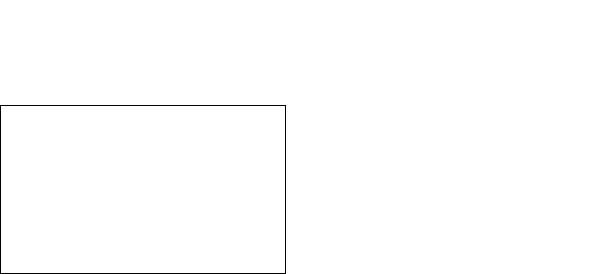
|
EBU00069 |
EBU00988 |
Clutch lever |
Brake lever |
|
The clutch lever is located on the left handle- |
The brake lever is located on the right handle- |
|
bar and the ignition circuit cut-off system is in- |
bar. Pull it toward the handlebar to apply the |
|
corporated in the clutch lever holder. Pull the |
front brake. |
|
clutch lever to the handlebar to disengage the |
|
|
clutch, and release the lever to engage the |
|
|
clutch. The lever should be pulled rapidly and |
|
|
released slowly for smooth clutch operation. |
|
|
(Refer to “Starting a cold engine” for a de- |
|
|
scription of the ignition circuit cut-off system.) |
|
1. Brake lever
1. Clutch lever
4-6

EBU00989
Brake pedal
The brake pedal is located on the right side of the machine. Push down on the pedal to apply the rear brake.
1. Brake pedal
4-7

EBU13870
Parking brake lever
Use the parking brake when you have to start the engine or park the machine, especially on a slope. To apply the parking brake, move the parking brake lever in direction a. To release the parking brake, move the parking brake lever in direction b.
1. Parking brake lever (Locked position)
1. Parking brake lever (Unlocked position)
4-8

WARNING
POTENTIAL HAZARD
Improper use of the parking brake. WHAT CAN HAPPEN
The ATV could start moving unexpectedly if the parking brake is not applied before starting the engine. This could cause loss of control or a collision.
The brake disc could overheat if you ride the ATV without releasing the parking brake. You could lose braking performance which could cause an accident. You could also wear out the brakes prematurely.
HOW TO AVOID THE HAZARD
Always set the parking brake before starting the engine.
Always be sure you have released the parking brake before you begin to ride.
EBU00082
Shift pedal
This machine is equipped with a constantmesh 6-speed transmission. The shift pedal is located on the left side of the engine and is used in combination with the clutch when shifting.
1. Shift pedal
4-9

|
EBU00085 |
EBU00092 |
Drive select lever |
Fuel tank cap |
|
The drive select lever is used for driving the |
Remove the fuel tank cap by turning it coun- |
|
machine either forward or in reverse. Refer to |
terclockwise. |
|
page 6-4 for drive select lever operation. |
|
1. Fuel tank cap
1. Drive select lever
4-10

EBU00930
Fuel cock
The fuel cock supplies fuel from the fuel tank to the carburetor.
The fuel cock has three positions.
OFF: With the lever in this position, fuel will not flow. Always turn the lever to this position when the engine is not running.
ON: With the lever in this position, fuel flows to the carburetor. Normal riding is done with the lever in this position.
RES: This indicates reserve. If you run out of fuel while riding, turn the lever to this position. THEN FILL THE FUEL TANK AT THE FIRST OPPORTUNITY. After refuelling, return the fuel cock lever to the “ON” position.
OFF Position
1. Arrow mark pointing to “OFF”
ON Position
1. Arrow mark pointing to “ON”
4-11

RES Position
1. Arrow mark pointing to “RES”
EBU00950
Starter (choke) “ 
Starting a cold engine requires a richer air-fuel mixture. A separate starter circuit supplies this mixture.
Move in direction a to turn on the starter (choke).
Move in direction b to turn off the starter (choke).
Refer to “Starting a cold engine” for proper operation. (See page 6-1.)
1. Starter (choke) “ 
4-12

EBU00567
Seat
To remove the seat, pull the seat lock lever upward and pull up the seat at the rear.
1. Seat lock lever
To install the seat, insert the projections on the front of the seat into the seat holders and push down on the seat at the rear.
NOTE:
Make sure that the seat is securely fitted.
|
1. Projection (× 2) |
2. Seat holder (× 2) |
4-13

EBU01104
Front shock absorber adjustment
The spring preload can be adjusted to suit the rider’s weight and riding conditions.
Adjust the spring preload as follows.
To increase the spring preload, turn the adjusting ring in direction a.
To decrease the spring preload, turn the adjusting ring in direction b.
|
1. Spring preload adjusting ring |
2. Position indicator |
NOTE:
A special wrench can be obtained at a Yamaha dealer to make this adjustment.
Standard position: C
A — Minimum (soft)
E — Maximum (hard)
1. Special wrench
4-14

WARNING
POTENTIAL HAZARD
Improper shock absorber adjustment. WHAT CAN HAPPEN
Uneven adjustment can cause poor handling and loss of stability, which could lead to an accident.
HOW TO AVOID THE HAZARD
Always adjust the shock absorbers on the left and right side to the same setting.
4-15

EBU12871
Rear shock absorber adjustment
The spring preload can be adjusted to suit the rider’s weight and riding conditions.
Adjust the spring preload as follows.
1.Loosen the locknut.
2.To increase the spring preload, turn the adjusting nut in direction a. To decrease the spring preload, turn the adjusting nut in direction b.
|
1. Locknut |
2. Spring preload adjusting nut |
CAUTION:
Never attempt to turn the adjusting nut beyond the maximum or minimum setting.
NOTE:
A special wrench can be obtained at a Yamaha dealer to make this adjustment.
1.Special wrench
3.The length of the spring changes 1.5 mm (0.06 in) per turn of the adjusting nut.
4-16

|
Measurement A: |
CAUTION: |
|||
|
Installed length: |
Always tighten the locknut against the ad- |
|||
|
Minimum (hard): 218.5 mm (8.6 in) |
justing nut and tighten it to the specified |
|||
|
Standard: 228.5 mm (9.0 in) |
torque. |
|||
|
Maximum (soft): 233.5 mm (9.2 in) |
||||
A
A.Spring length
4.Tighten the locknut to the specified torque.
Tightening torque:
42 Nm (4.2 m·kgf, 30 ft·lbf)
4-17

WARNING
POTENTIAL HAZARD
This shock absorber contains highly pressurized nitrogen gas.
WHAT CAN HAPPEN
The shock absorber could explode, causing injury or property damage. Cylinder damage could also result in poor handling which could cause an accident.
HOW TO AVOID THE HAZARD
●Do not tamper with or attempt to open the cylinder assembly.
●Do not subject the shock absorber to an open flame or other high heat.
●Do not deform or damage the cylinder in any way.
●Do not dispose of a damaged or worn out shock absorber yourself. Take the unit to a Yamaha dealer.
EBU00112

Indicates a potential hazard that could result in serious injury or death.
4-18
PRE-OPERATION CHECKS
Before using this machine, check the following points:
|
ITEM |
ROUTINE |
PAGE |
|||
|
Brakes |
• Check operation, fluid level and fluid leakage. |
5-2–5-3, |
|||
|
• Fill with DOT 4 brake fluid if necessary. |
8-19–8-24 |
||||
|
Clutch |
• Check operation, condition and lever free play. |
8-27–8-28 |
|||
|
5 |
|||||
|
Parking brake |
• Check operation, condition and cable length. |
8-25–8-26 |
|||
|
Fuel |
• Check fuel level. |
5-4–5-5 |
|||
|
• Fill with fuel if necessary. |
|||||
|
Engine oil |
• Check oil level. |
5-6, 8-6–8-9 |
|||
|
• Fill with oil if necessary. |
|||||
|
Drive chain |
• Check chain slack and condition. |
5-6, 8-29–8-32 |
|||
|
• Adjust if necessary. |
|||||
|
Throttle |
• Check for proper throttle cable operation and free play. |
5-6, 8-19 |
|||
|
Wheels and tires |
• Check tire pressure, wear and damage. |
5-8–5-10, |
|||
|
8-37–8-38 |
|||||
|
Fittings and fasteners |
• Check all fittings and fasteners. |
5-6 |
|||
|
Lights and switches |
• Check for proper operation. |
5-7, 8-27, 8-42–8-46 |
|||
5-1

WARNING
POTENTIAL HAZARD
Failure to inspect the ATV before operating.
Failure to properly maintain the ATV.
WHAT CAN HAPPEN
Increases the possibility of an accident or equipment damage.
HOW TO AVOID THE HAZARD
Always inspect your ATV each time you use it to make sure the ATV is in safe operating condition.
Always follow the inspection and maintenance procedures and schedules described in the Owner’s Manual.
EBU01166
Front and rear brakes
Brake lever and brake pedal
●Check that there is no free play in the brake lever. If there is free play, have a Yamaha dealer inspect the brake system.
●Check for correct brake pedal height. (See page 8-24.) If the pedal height is incorrect, have a Yamaha dealer adjust it.
●Check the operation of the lever and pedal. They should move smoothly and there should be a firm feeling when the brakes are applied. If not, have a Yamaha dealer
inspect the brake system.
Brake fluid level
Check the brake fluid level. Add fluid if necessary. (See pages 8-21–8-22.)
Recommended brake fluid: DOT 4
5-2

Brake fluid leakage
Check to see if any brake fluid is leaking out of the pipe joints or brake fluid reservoirs. Apply the brakes firmly for one minute. If there is any leakage, have a Yamaha dealer inspect the brake system.
Brake operation
Test the brakes at slow speed after starting out to make sure they are working properly. If the brakes do not provide proper braking performance, inspect the brake pads for wear. (See pages 8-19–8-20.)
WARNING
POTENTIAL HAZARD
Riding with improperly operating brakes.
WHAT CAN HAPPEN
You could lose braking ability, which could lead to an accident.
HOW TO AVOID THE HAZARD
Always check the brakes at the start of every ride. Do not ride the ATV if you find any problem with the brakes. If a problem cannot be corrected by the adjustment procedures provided in this manual, have a Yamaha dealer check for the cause.
5-3

EBU01085
Fuel
Make sure there is sufficient gasoline in the tank.
Recommended fuel: UNLEADED GASOLINE ONLY
Fuel tank capacity: Total:
9.0 L (1.98 Imp gal, 2.38 US gal) Reserve:
2.7 L (0.59 Imp gal, 0.71 US gal)
CAUTION:
Use only unleaded gasoline. The use of leaded gasoline will cause severe damage to internal engine parts, such as the valves and piston rings, as well as to the exhaust system.
Your Yamaha engine has been designed to use regular unleaded gasoline with a pump octane number ([R+M]/2) of 86 or higher, or research octane number of 91 or higher. If knocking or pinging occurs, use a different brand of gasoline or premium unleaded fuel. Unleaded fuel will give you longer spark plug life and reduced maintenance cost.
5-4

Gasohol
There are two types of gasohol; gasohol containing ethanol and that containing methanol. Gasohol containing ethanol can be used if ethanol content does not exceed 10%. Gasohol containing methanol is not recommended by Yamaha because it may cause fuel system damage or vehicle performance problems.
|
1. Fuel tank filler tube |
2. Fuel level |
WARNING
POTENTIAL HAZARD Improper care when refueling. WHAT CAN HAPPEN
Fuel can spill, which can cause a fire and severe injury.
Fuel expands when it heats up. If the fuel tank is overfilled, fuel could spill out due to heat from the engine or the sun.
HOW TO AVOID THE HAZARD
Do not overfill the fuel tank. Be careful not to spill fuel, especially on the engine or exhaust pipe. Wipe up any spilled fuel immediately. Be sure the fuel tank cap is closed securely.
Do not refuel right after the engine has been running and is still very hot.
5-5

EBU10842
Engine oil
Make sure the engine oil is at the specified level. Add oil as necessary. (See pages 8-6– 8-9.)
CAUTION:
●In order to prevent clutch slippage (since the engine oil also lubricates the clutch), do not mix any chemical additives. Do not use oils with a diesel specification of “CD” or oils of a higher quality than specified. In addition, do not use oils labeled “ENERGY CONSERVING II” or higher.
●Make sure that no foreign material enters the crankcase.
Recommended engine oil type and quantity:
See page 10-2.
EBU00498
Chain
Check the general condition of the chain and check the chain slack before every ride. Lubricate and adjust the chain as necessary. (See pages 8-29–8-32 for details.)
EBU01083
Throttle lever
Check to see that the throttle lever operates correctly. It must open smoothly and spring back to the idle position when released. Have a Yamaha dealer repair as necessary for proper operation.
EBU01162
Fittings and fasteners
Always check the tightness of chassis fittings and fasteners before a ride. Take the machine to a Yamaha dealer or refer to the Service Manual for correct tightening torque.
5-6
EBU01003
Lights
Check the headlights and tail/brake light to make sure they are in working condition. Repair as necessary for proper operation.
EBU01170
Switches
Check the operation of all switches. Have a Yamaha dealer repair as necessary for proper operation.
5-7

EBU00157
Tires
WARNING
POTENTIAL HAZARD
Operating this ATV with improper tires, or with improper or uneven tire pressure.
WHAT CAN HAPPEN
Use of improper tires on this ATV, or operation of this ATV with improper or uneven tire pressure, may cause loss of control, increasing your risk of accident.
HOW TO AVOID THE HAZARD
1.The tires listed below have been approved by Yamaha Motor Co., Ltd. for this model. Other tire combinations are not recommended.
|
Manufacturer |
Size |
Type |
||
|
Front |
DUNLOP |
AT21 × 7 — 10 |
KT851B |
|
|
Rear |
DUNLOP |
AT20 × 10 |
— 9 |
KT877A |
2.The tires should be set to the recommended pressure:
●Recommended tire pressure
Front 25 kPa (0.25 kgf/cm2, 3.6 psi) Rear 25 kPa (0.25 kgf/cm2, 3.6 psi)
●Check and adjust tire pressures when the tires are cold.
●Tire pressures must be equal on both sides.
3.Tire pressure below the minimum specified could cause the tire to dislodge from the rim under severe riding conditions.
The following are minimums:
Front 22 kPa (0.22 kgf/cm2, 3.2 psi) Rear 22 kPa (0.22 kgf/cm2, 3.2 psi)
5-8

4.Use no more than the following pressures when seating the tire
beads.
Front 250 kPa (2.5 kgf/cm2, 36 psi) Rear 250 kPa (2.5 kgf/cm2, 36 psi)
Higher pressures may cause the tire to burst. Inflate the tires very slowly and carefully. Fast inflation could cause the tire to burst.
EBU00159
How to measure tire pressure
Use the low-pressure tire gauge.
NOTE:
The low-pressure tire gauge is included as standard equipment. Make two measurements of the tire pressure and use the second reading. Dust or dirt in the gauge could cause the first reading to be incorrect.
Set pressure with tires cold.
Set tire pressures to the following specifications:
|
Recommended |
Minimum |
Maximum |
||
|
pressure |
||||
|
25 kPa |
22 kPa |
28 kPa |
||
|
Front |
(0.25 kgf/cm2, |
(0.22 kgf/cm2, |
(0.28 kgf/cm2, |
|
|
3.6 psi) |
3.2 psi) |
4.1 psi) |
||
|
25 kPa |
22 kPa |
28 kPa |
||
|
Rear |
(0.25 kgf/cm2, |
(0.22 kgf/cm2, |
(0.28 kgf/cm2, |
|
|
3.6 psi) |
3.2 psi) |
4.1 psi) |
||
1. Low-pressure tire gauge
5-9

EBU00160
Tire wear limit
When the tire groove decreases to 3 mm (0.12 in) due to wear, replace the tire.
a. Tire wear limit
5-10

Yamaha RAPTOR 350: List of Available Documents
Note for Owners:
Guidesimo.com webproject is not a service center of Yamaha trademark and does not carries out works for diagnosis and repair of faulty Yamaha RAPTOR 350 equipment. For quality services, please contact an official service center of Yamaha company. On our website you can read and download documentation for your Yamaha RAPTOR 350 device for free and familiarize yourself with the technical specifications of device.
More Offroad Vehicle Devices:
-
Dynojet Power commander v
12-006 www.powercommander.com 2007-2009 BMW G650X — PCV — 1PARTS LIST1 Power Commander1 USB Cable1 Installation Guide2 Power Commander Decals2 Dynojet Decals2 Velcro strips1 Alcohol swab2 Posi-tapsTHE LATEST POWER COMMANDER SOFTWARE AND MAP FILES CAN BE DOWNLOADED FROM OUR WEB SITE AT:www.powercommander.com2007-2009 BMW G650XInstallation InstructionsPLEASE READ ALL DIRECTIONS BEFORE …
Power commander v Automobile Accessories, 6
-
BRP Can-Am Outlander 450 STD 2022
OUTLANDER AND OUTLANDER MAX — TCATEGORYOPERATOR’SGUIDEIncludes Safety, Use and Maintenance Information2022WARNINGRead this operator’s guide thoroughly. It contains important safety information.Minimum recommended operator age: 16 or older with a valid driver’s license.Keep this operator’s guide with the vehicle at all times.219002203Original Instructions …
Can-Am Outlander 450 STD 2022 Offroad Vehicle, 220
-
Polaris 2011 PREDATOR 50
GENERAL INFORMATION1.1CHAPTER 1GENERAL INFORMATION19923074 — 2011 Youth 4-Stroke Service Manual© Copyright 2010 Polaris Sales Inc.MODEL INFORMATION . . . . . . . . . . . . . . . . . . . . . . . . . . . . . . . . . . . . . . . . . . . . . . . . . . 1.2MODEL IDENTIFICATION . . . . . . . . . . . . . . . . . . . . . . . . . . . . . . . . . . . . . . . . . . . . . . . . 1.2ENGINE DESIGNATION NUMBERS . …
2011 PREDATOR 50 Offroad Vehicle, 12
-
Polaris 2013 RANGER RZR
GENERAL INFORMATION1.1CHAPTER 1GENERAL INFORMATION19924125 — 2013 RANGER RZR / RZR S / RZR 4 Service Manual© Copyright 2012 Polaris Sales Inc.VEHICLE IDENTIFICATION . . . . . . . . . . . . . . . . . . . . . . . . . . . . . . . . . . . . . . . . . . . . . . . 1.2MODEL NUMBER DESIGNATION. . . . . . . . . . . . . . . . . . . . . . . . . . . . . . . . . . . . . . . . . . 1.2ENGINE DESIGNATION NUMBER …
2013 RANGER RZR Offroad Vehicle, 430
-
Yamaha YFM350S
5YT-28199-10LIT-11626-17-57READ THIS MANUAL CAREFULLY!It contains important safety information.This ATV should not be ridden by anyone under 16 years of age.WARNINGYFM350SOWNER’S MANUALPRINTED IN JAPAN2003.12-2.0×1 CR(E)PRINTED ON RECYCLED PAPERYAMAHA MOTOR CO., LTD.EBU00438LOCATE AND READ OWNER’S MANUAL. FOLLOW ALL INSTRUCTIONS AND WARNINGS.(For replacement manual, call 1-800-532-1558)WARNIN …
YFM350S Offroad Vehicle, 173
Recommended Documentation:
Service Manual Raptor 350 Repair Manual For A Yamaha 350 Raptor. I m a subscriber to your Yamaha Raptor 350 manual and I want to thank you. Using your online service I was able. Yamaha Raptor 350 Repair Manual. This is a COMPLETE Service & Repair Manual for Yamaha Raptor 350 service manual repair. 2004 YFM350. This manual. Does anyone have a link to a service manual that works? This is a discussion on 06 Raptor 350 Service Manual within the Yamaha YFM350 Raptor/Warrior. Using your online service I was able to disassemble a spare YFM 350 for salvage parts Full Yamaha Raptor 660 Service Repair Manual available. Yamaha YFM50 Raptor Service Repair Manual 2004 to 2008. Kevin Walker FIX Warrior 350. Owners Experience, Boating Safety · Team Indmar Club · Owners Photo Gallery · Events. Service & Support, Warranty · Maintaining Your Indmar · Manuals. Service Manual Raptor 350 >>>CLICK HERE<<< 2001 raptor 660 manual can be safely held in your pc for future repair work. If you learn your 2006 YAMAHA RAPTOR 350 OWNERS MANUAL. Last update. Topic of the manual is around the biggest of such yamaha raptor 50cc repair Download Haynes Yamaha Banshee, Warrior and Raptor 350 ATV: Service. INSTANT DOWNLOAD Yamaha YFM350 Raptor 350, Warrior 350 ATV (all-terrain-vehicle) repair manual. A repair manual is a professional book of instructions. Topic with this manual is all about the biggest of the yamaha raptor 700r manual free download can YAMAHA RAPTOR 350 SERVICE MANUAL DOWNLOAD. This service repair manual covers the 2004-2013 Yamaha Raptor 350 YFM350 YFM350R. This manual will save you money by doing it yourself. Manual comes. Our nationwide network of 04 raptor 660
Table of Contents for Yamaha RAPTOR 350:
-
3-2 1 2 3 4 5 6 7 8 9 10 11 12 13 14 EBU00600 Identification number records Record the key identification number, vehicle identification number and model label infor- mation in the spaces provided for assistance when ordering spare parts from a Yamaha dealer or for reference in case the vehicle is stolen. 1. KEY IDENTIFICATION NUMBER: 2. VEHICLE IDENTIFICATION NUMBER: 3. MODEL LABEL INFORMATION: EBU00035 Key identification number The key identification number is stamped on the key as shown in the following
-
8-14 1. Element retaining plate 2. Frame 3. Air filter element 4. Air filter element seat 4. Wash the element gently but thoroughly in solvent. 5. Squeeze the excess solvent out of the air filter element and let it dry. CAUTION: _ Do not twist the air filter element when squeezing it. _ 6. Inspect the air filter element and replace it if damaged. WARNING POTENTIAL HAZARD Using low flash point solvents or gaso- li
-
8-26 NOTE: _ If the cable cannot be adjusted to specifica- tion, consult a Yamaha dealer. _ 5. Tighten the locknut on the brake cable. 6. Screw in the adjusting bolt at the rear brake caliper until it feels tight, and then screw it out 1/8 turn. Tighten the locknut to the specified torque. CAUTION: _ When tightening the locknut, hold the ad- justing bolt with a wrench so that the ad- justing bolt does not turn together with the locknut. _ Tightening torque: Locknut: 16 Nm (1.6 m·kgf, 11 ft·lbf) WARNING POTENTIAL HAZARD Operating with improperly
-
8-1 EBU00515 PERIODIC MAINTENANCE AND ADJUSTMENT Periodic inspection, adjustment and lubrica- tion will keep your machine in the safest and most efficient condition possible. Safety is an obligation of the machine owner. The most important points of machine inspection, ad- justment and lubrication are explained on the following pages. EBU01221 Owner’s manual and tool kit You are recommended to put this owner’s manual and low-pressure tire gauge in the vi- nyl bag and always carry them along with the owner’s tool kit under the seat. 1. Ow
-
PRE-OPERATION CHECKS ……….. 5-1 Front and rear brakes ………………… 5-2 Fuel …………………………………………. 5-4 Engine oil …………………………………. 5-6 Chain……………………………………….. 5-6 Throttle lever …………………………….. 5-6 Fittings and fasteners…………………. 5-6 Lights……………………………………….. 5-7 Switches…………………………………… 5-7 Tires …………………………………………
-
3-3 EBU00036 Vehicle identification number The vehicle identification number is stamped into the frame. 1. Vehicle identification number N O TE: The vehicle identification number is used to identify your machine. EBU00787 Model label The model label is affixed to the location in the illustration. Record the information on this la- bel in the space provided. This information will be needed to order spare parts from your Yamaha dealer. 1. Model label U5YT13.book
-
8-13 1. Air filter case cover 2. Holder (× 4) 3. Remove the air filter element assembly, and then remove the air filter element from its frame. 1. Air filter element assembly U5YT13.book Page 13 Wednesday, June 29, 2005 10:35 AM
-
EBU00437 U5YT13.book Page 3 Wednesday, June 29, 2005 10:35 AM
-
8-8 5. Remove the oil filter cover by removing the bolts, and then remove the oil filter el- ement. 6. Clean the oil strainer and oil filter element with solvent. 1. Engine oil filter cover 2. Bolt (× 3) 3. Engine oil filter element 4. O-ring 7. Check the O-ring for damage and re- place it if necessary. 8. Install the oil filter element and O-ring. NOTE: _ Make sure the O-ring is seated properly. _ 9. Install the oil filter cover by installing the bolts, and then tighte
-
7-22 CAUTION: _ Do not shift gears without releasing the throttle. Damage to the engine or drive train may occur. _ When slowing down or stopping, release the throttle and apply the brakes smoothly and evenly. As you slow down, shift to a lower gear. Be sure that the engine has sufficiently slowed before engaging a lower gear. Improp- er use of the brakes or shifting can cause the tires to lose traction, reducing
-
8-17 EBU00296 Carburetor adjustment The carburetor is a vital part of the engine and requires very sophisticated adjustment. Most adjusting should be left to a Yamaha dealer who has the professional knowledge and ex- perience to do so. However, the idling speed may be performed by the owner as a part of the usual maintenance routine. CAUTION: The carburetor was set at the Yamaha fac- tory after many tests. If the settings are disturbed by someone without sufficient technical knowledge, poor engine perfor- mance and damage may res
-
5-8 EBU00157 Tires WARNING POTENTIAL HAZARD Operating this ATV with improper tires, or with improper or uneven tire pres- sure. WHAT CAN HAPPEN Use of improper tires on this ATV, or op- eration of this ATV with improper or un- even tire pressure, may cause loss of control, increasing your risk of acci- dent. HOW TO AVOID THE HAZARD 1. The tires listed below have been ap- proved by Yamaha Motor Co., Ltd. for this model. Other tire combina-
Questions, Opinions and Exploitation Impressions:
You can ask a question, express your opinion or share our experience of Yamaha RAPTOR 350 device using right now.


 SAFETY INFORMATION
SAFETY INFORMATION






